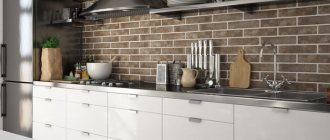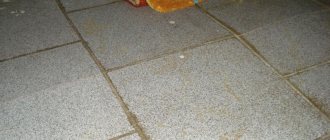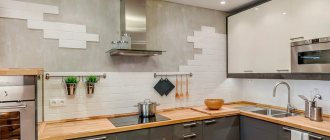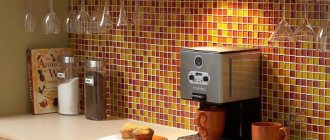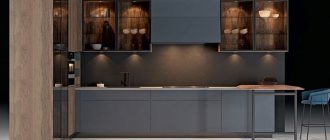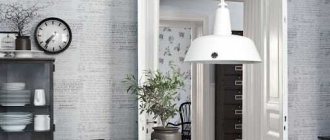An apron in the kitchen is an integral part of the interior. Regardless of the size of the room, an apron can become a bright accent with a minimal investment of money. The most successful solution is to use materials such as tiles and glass. But in order to appreciate all the advantages of ceramic tiles, let’s consider the advantages and disadvantages of all types of materials that can be used for a backsplash.
Please note that for the harmony of space it is necessary to respect the proportions of the kitchen itself and the density of the objects located in it. That is, the smaller the size of the kitchen, the more kitchen items, and the more minimalist the apron should look.
Kitchen apron standards
The height of the apron, or as it is also called the width, according to the standard varies from 50 to 60 cm. Why is there no specific number? This is simply explained. This run-up is influenced by the height of the person, as well as the type of slab. When using a ceramic model with a standard size of 30 cm, the standard for the apron will be 60+0.1 cm (two 30 cm tiles and a seam between them). But it's true, it's a classic. With today's variety of sizes of ceramic tiles, the height of the apron can be different. Everything is selected individually.
The height is also affected by such a nuance as the hood. If the model is built-in, then this does not affect anything. But if it is not built-in, then the apron will be higher (due to the fact that the hood is installed at a distance of 70-80 cm from the stove). This extra distance must be taken into account, as it entails additional material costs.
Another important point that must be remembered and taken into account when installing the apron is that the height of the covering must be 2-3 cm so that it goes directly under the cabinets.
In order for the apron to fit organically into the interior, it is necessary to install it around the entire perimeter of the kitchen, and not be limited to areas above the sink and stove. Yes, these are the most problematic places in the kitchen, but the cooking area also cannot boast of cleanliness. The savings here are questionable.
A good option for a corner sink would be to install an apron completely around it, that is, taking into account the perpendicular wall.
Tiles for the kitchen - features of the choice and design of the room
Kitchen tiles can also appeal to supporters of traditional furnishing solutions. For those who do not want to follow the latest trends, manufacturers offer equally interesting options. They will work in traditional kitchens, are versatile and timeless.
Retro kitchen tiles will have the most traditional look. In the 1950s and 1960s, these tiles became a permanent part of kitchen design. If you want to create inspiration in this style, you should look for tiles in pastel colors that will create a feminine space. Fashionable retro kitchen tiles with a checkerboard motif are also perfect for the kitchen. This pattern can be used both on the wall and on the floor. The black and white glaze combination is also suitable for minimalist and glamorous kitchens.
White kitchen tiles have also been popular for several seasons. It fits into the Scandinavian style kitchen trend, but will look good in any interior. Modern kitchen tiles in a white shade can take a “subway” shape or imitate wood.
Lovers of brightness can choose glazed tiles, which are shiny or polished tiles that give a mirror effect. They bring modernity and unusual arrangement effects to the interior. Glass tiles for the kitchen are an ideal solution for small interiors, which visually increases.
Choice of color and design solution
The color scheme is not a determining factor, as it does not affect its practicality. The color of the apron depends only on your preference and kitchen design. And dirt, of which there is plenty in the kitchen, will be visible in any case if you do not put things in order in a timely manner.
But what you really need to pay attention to is the texture of the selected material. It is better to give preference to a non-uniform solution, then the spots will not be so noticeable. Imitation of marble, stone, wood is suitable. But on a uniform texture, even a slight speck will be noticeable.
As for the shade, it is better to prefer a light option than a dark one. Salt stains after water will not be so visible. But it is better to use gray grout for the joints, so the coating will look more attractive.
If you are attracted to bright colors, then make sure that the kitchen apron matches the textiles. These are two fundamental ones that will determine what the kitchen looks like as a whole.
If you prefer a monochrome direction, then it would not be superfluous to dilute such an interior with a rich palette, for example, all shades of green. In green it is easy to choose all kinds of kitchen accessories in the form of towels and potholders.
And if your kitchen is small, then without hesitation, only plain options without any unnecessary details.
Tips for choosing
Before thinking about the question: how to lay tiles in the kitchen on an apron, you need to decide on the type of facing material, adhesive and grout composition, prepare tools and other related products. There are also some points, taking into account which makes the main task easier:
- It is better to purchase wall tiles with a chemical-protective coating. Such products are designated “A”, more secure ones are designated “AA”.
- The same type of tile from different batches can vary significantly in shade. Therefore, when purchasing products, you must carefully check the compliance of the labeling on the packaging.
- Products from each batch may vary in size and size. Therefore, you need to pay attention to the caliber. It is desirable that this indicator on the packages be the same or the difference should be no more than one.
- You need to check the quality of the surface right at the point of sale. It should be free of roughness, unevenness, abrasions, chips, cracks and other defects.
- Store the tiles in a dry place, avoiding getting the back side wet. Otherwise, after some time, the front side will crack.
- A big problem is created by the seams between the tiles, as the grout loses its attractive appearance over time. Using a high-quality, moisture- and dirt-resistant grout with antifungal properties will help preserve it. The problem is also solved by using rectified tiles. Many consumers recommend tiling the kitchen backsplash with Leroy Merlin tiles.
Kitchen apron made of ceramic tiles
By choosing ceramic tiles, you will really find the best option, since the choice is huge: any color, texture, size. The tile looks very cool under lighting, it has no equal here. The only drawback is the grout for the joints, but with the right choice, this drawback can be minimized.
When calculating the square footage of the apron, do not count on large numbers, even if the kitchen is huge. Therefore, you should not cut your budget, but take advantage of the opportunity to purchase the tiles you dream of, despite the price.
Ceramic tiles with imitation marble or wood will always look cool. But the main thing is that it is an imitation of not only the pattern, but also the texture.
A white boar tile would look like a win-win option. He has firmly taken his leading position and is not going to give it up. And all thanks to the fact that such tiles are perfect for both classic and modern styles. A white boar will always look relevant and advantageous, as it is a time-tested option.
When arranging a kitchen in a classic style, you won’t find a better option than ceramic tiles for a backsplash.
Apron appearance
A kitchen apron is not only a practical wall protection, it is part of the decor. The right colors and tile pattern design will help create a cozy atmosphere in the kitchen and, therefore, become not only a “dining room” where people come to eat, but also a place where you can sit and chat with family or friends. with a cup of coffee or tea.
You need to start by choosing a color scheme. This task becomes quite simple if you follow a few rules:
- An apron in a colored kitchen should match the color of the furniture-free walls;
- Or it should match a specific element in the kitchen (for example, curtains, wall panels or plates).
Kitchen apron made of photo tiles
But if your choice fell on an apron made of photo tiles, then you need to remember that photo tiles are inferior to a glass apron. And if desired, the drawing can be placed under a glass apron. For the kitchen there is no point in loading the apron with a pattern; it is more appropriate as an accent on the wall in the bathroom.
The only advantage of photo tiles is that you can create the design yourself.
Kitchen tiles: price, quantity, calculations
Kitchen tiles must be purchased in the required quantity. First, you need to think about what surfaces will be tiled. If the tiles are laid on the entire wall, then the surface of the holes and strips should be subtracted from it. When mosaic tiles for the kitchen, you should also remember that you need to determine the number of specific designs.
Prices for kitchen tiles start at 350 rubles per m2 and increase. For high-quality tiles with fashionable designs and colors, you should pay even more than 8,000 rubles per m2.
Glass kitchen apron
An apron made of tempered glass or skinali is an ideal solution for finishing an apron. Skinali can easily compete with ceramic tiles. Skinali is a durable and smooth material, the surface of which can be either matte or glossy. And for lovers of drawings, it is possible to place it under glass. Just select and print.
But the optimal solution, of course, would be to simply choose a color. And kitchen utensils will add accents. A glass apron would look appropriate in a high-tech style.
In terms of practicality, glass can be compared to ceramic tiles:
- Easy to install.
- The surface was easily washed off, even old dirt.
- Huge selection of images.
- There is only one texture - smooth.
As for the price, it is adequate. The cost of a linear meter of skinali is comparable to that of good quality ceramic tiles.
Fashionable tiles for the kitchen - patterns, colors, textures
Tile trends change every season. In 2022, modernity and minimalism are the dominant trends. The most popular is white tiles for the kitchen, which are combined with dark matte and semi-matte furniture, as well as elements made of gold, dark blue and turquoise and shades of natural wood.
If we have a small kitchen that is open to other rooms, then it is worth choosing one type of tile throughout the entire interior. This procedure will significantly affect the optical expansion of the apartment.
Kitchen apron made of laminated MDF and chipboard
This apron is an excellent solution - price equals quality. The apron is made from laminated MDF and chipboard in the same way as the tabletop itself. Its essence is that the wood adhesive material is laminated with plastic on all sides.
The features of this apron include:
- Easy to install and dismantle.
- Easy care.
- The apron can be made under the tabletop or under the facades of furniture.
- Price-quality ratio. And in terms of cost, it’s a small waste of money.
Why is tile the most popular finish?
The kitchen apron is most often laid with tiles. And this is explained by the high quality of the cladding.
Photo: Instagram nikitazub.design
Photo: Instagram nikitazub.design
- She is not afraid of direct streams of water and chemicals.
- And also temperature changes.
- Not difficult to wash.
- It will last for ten years or even more.
- You can choose a variety of types.
- Kitchen
Kitchen apron design (70 photos)
Mosaic kitchen apron
A mosaic apron is always interesting and relevant, expensive and stylish. But the abundance of seams is a serious point that is worth thinking about. Therefore, using mosaic for a backsplash is impractical; it will quickly lose its presentation. And the use of epoxy fugue is a costly undertaking. But, if financial costs don’t stop you, then yes. Or you should abandon this option altogether.
But an alternative still exists. And the name for this is pseudomosaic - ceramic tiles that imitate mosaics in both texture and pattern. Pseudo-mosaic will be cheaper in price than the mosaic itself and there will be fewer seams, and this is a decisive point for an apron. And the selected grout to match the color of the fake seams in the picture will give you the full feeling that this is an original mosaic.
Tile module shape
Equally important is the shape of each module. Today, the building materials market offers a wide range of products at affordable prices.
Among the most popular tile shapes are:
- Classic square. Similar tiles can most often be found on store shelves. It has the most different designs and is most convenient when laying an apron. Made from ceramics or tempered glass with photo printing.
- Boar tiles are an indispensable option for covering a kitchen backsplash. It has the shape of a rectangle with beveled side edges. When laying, it allows you to imitate a brick wall. As a rule, it is sold in limited color options (white, cream, yellowish tint).
- Mosaic allows you to create a universal design indoors. This type of tile never loses its popularity. It consists of miniature squares made of tempered glass. A pleasant glossy shine creates a special visual effect in the kitchen, which is used for arranging small rooms.
New finishing materials, which have already earned the attention of craftsmen and designers, allow you to create the most incredible designs on the apron.
To cover the apron, tiles with embossed edges and blocks are used to create a mosaic image. However, to install such a coating you will need the help of a specialist, and this material is very demanding in terms of care.
Kitchen apron made from a mirror
Mirrors can be considered rare materials for an apron. As for the appearance, it is luxurious and expensive, but as for cleaning, it is long and painful. But, if you still make your choice in favor of a mirror for the apron, you must remember that the kitchen should always be in perfect clean condition. Such an apron will not tolerate any kind of disorder. Extra items are not acceptable. And, of course, you can’t attach roof rails to such an apron.
But, if you do not give up the dream of a mirrored surface of the apron, it is better to give your preference to glossy tiles or skinned ones. And the mirror version is only good for the picture.
Caring for a tiled apron
Caring for a tiled backsplash was considered easy. The surface is added for wiping immediately after preparation with a soft sponge moistened with soapy water. Allowing grease stains to dry will allow them to dry out.
A smooth, shiny or matte surface is considered ideal for cleaning. Both options should be wiped so as not to leave soap marks or smudges on them. After wet cleaning, it is recommended to wipe the surface of the apron with a dry soft towel.
Hexagonal tiles - for the brave
Modern interiors love non-obvious solutions that diverge from what is known and traditional. It is therefore not surprising that kitchens designed in this way are moving away from standard, square or rectangular shaped wall and floor tiles. So you can get carried away by your imagination and choose tiles in an unusual shape. Hexagonal, that is, honeycomb tiles are currently very popular to create various compositions.
Expert advice! Hexagons fit perfectly into the Art Deco style, especially if they are in a shiny color such as pewter or gold.
Photo
For inspiration, look at photo examples of popular masonry in real interiors:
How do you like the article?
How to combine tiles with other kitchen elements?
In interior design, it is important to maintain harmony and uniformity of style. If you choose dark furniture, be sure to balance it with, for example, a light wall or floor color. Same thing with kitchen tiles. If the kitchen is dominated by dark, almost black furniture, you should choose a lighter shade of tiles for the walls and floors. Wall tiles can contrast with the color of the furniture or blend harmoniously with it. If you care about maintaining similar colors in the interior, you can diversify the wall cladding with decor, the design of which will add dynamics to the design.
It is also important to match the tiles to the overall style. If the kitchen is made in a vintage style, then small square tiles that imitate old tiled stoves will be a good choice. If you choose a trendy Scandinavian style, limit the colors in your kitchen to shades of white, black and brown.
Expert advice! Wall tiles can be fixed not only horizontally, but also vertically. An interesting effect is achieved by applying an appropriate shift or choosing tiles in the original hexagon shape. The joint you use for the backsplash will also be significant. This color analogue will be the least noticeable, which will have a good effect on the decor of a muted kitchen. Conversely, a contrasting grout will allow you to highlight the interesting tile arrangement, but be careful not to make the space appear smaller.
The texture and patterns on the tiles are also important. Tile with clear geometric patterns can be chosen for single-color kitchen facades. Wooden furniture combined with a clear tile texture that imitates concrete, for example, is not the best combination. This type of finish will be better in spacious loft-style kitchens.
Layout options
There are several ways to make a kitchen backsplash from ceramic tiles. The simplest is the traditional one, butt-to-butt. Suitable for both square and rectangular products. Squares can also be laid diagonally, corner to corner.
Another way is with an offset. It looks more interesting, but requires cutting of material, which means increased costs.
The photo shows a corner kitchen with an apron made of a rectangular “hog” laid in a straight line.
Hog tiles offer much more layout options. Products can be laid vertically (straightly or offset), which is important in apartments with low ceilings: an elongated layout will visually lengthen the room.
Rectangular tiles can be laid in a herringbone pattern (like parquet) or in a ladder pattern (with a slight offset). The result is an unusual pattern that attracts attention and decorates the kitchen. The disadvantage of such methods is the need for pruning.
The photo shows a kitchen apron made of sand-colored relief tiles laid vertically.
Hexagonal honeycombs and scales are glued over the work area in the traditional way.
